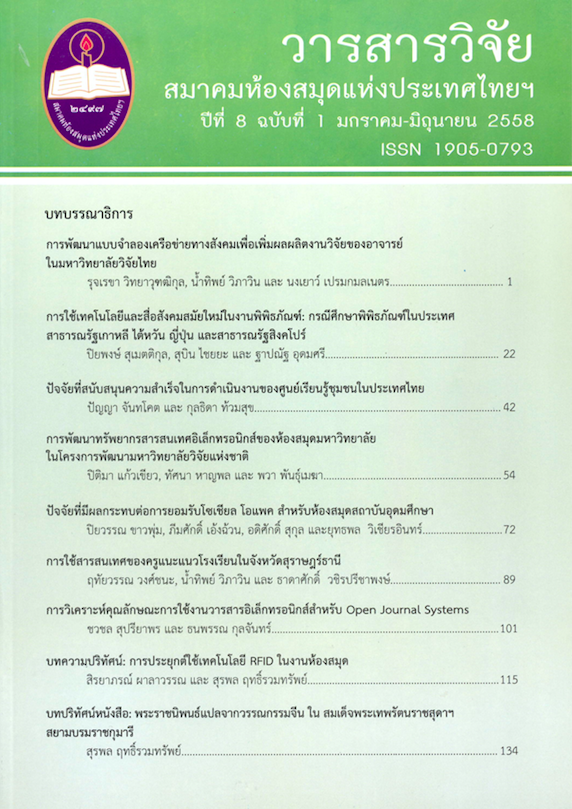การประยุกต์ใช้เทคโนโลยี RFID ในงานห้องสมุด
Main Article Content
Abstract
เทคโนโลยี RFID (Radio Frequency Identification System) เป็นระบบที่ใช้สัญญาณคลื่นวิทยุในการตรวจสอบและระบุตำแหน่งวัตถุ ซึ่งสามารถนำมาประยุกต์ใช้ในการให้บริการห้องสมุดได้เป็นอย่างดี โดยระบบจะอ่านข้อมูลจากแผ่นข้อมูล RFID Tag ที่ติดอยู่กับหนังสือ และเชื่อมโยงกับโปรแกรมระบบบริหารงานห้องสมุด ในการยืม-คืนหนังสือด้วยตนเอง การตรวจสอบสถานภาพการยืม การควบคุมการเข้า-ออกห้องสมุด การสำรวจและการค้นหาหนังสือ เป็นต้น คลื่นความถี่วิทยุที่ใช้ในระบบ RFID ที่เหมาะสมกับงานห้องสมุดในปัจจุบันมีอยู่ 2 ย่านความถี่ ประกอบด้วย คลื่นวิทยุย่านความถี่สูง (High Frequency: HF) และคลื่นวิทยุย่านความถี่สูงยิ่ง (Ultra High Frequency: UHF) มีงานวิจัยหลายชิ้นได้ศึกษาเปรียบเทียบข้อดีข้อเสีย และข้อจำกัด ของคลื่นความถี่ทั้งสอง ดังนั้นการตัดสินใจนำระบบ RFID มาใช้ในงานห้องสมุด ควรพิจารณาวางแผนอย่างรอบคอบ ศึกษามาตรฐานและปัจจัยต่างๆที่เกี่ยวข้อง รวมถึงกำหนดคุณสมบัติของระบบที่ต้องการอย่างเหมาะสม
Implementing RFID Technology in Library
Sirayaporn Phalawan1, Surapol Ritruamsup2
1B.A. (Information Studies) First Class Honors, Librarian of Mahidol Wittayanusorn School (Public Organization)
2B.A. (Library Science), M.A. (Library and Information Science), Specialist, Head of Academic Resource Department, Mahidol Wittayanusorn School (Public Organization)
RFID (Radio Frequency Identification) is the technology that uses radio wave to identify objects automatically. This technology has been applied to library services; by storing data in RFID tag and attaching it inside the book, the tag will be read by the interrogator and the data will be transformed to the library management system for using with self-check-in/check-out station, security management, book sorting and inventory checking, etc. RFID for library operates with High Frequency (HF) and Ultra High Frequency (UHF) types. Thus, to implement RFID in library, related standards and topics should be considered and planned carefully; including defines attributes of the system appropriately.
Article Details
บทความทุกเรื่องที่ลงตีพิมพ์จะได้รับการตรวจอ่านโดยผู้ทรงคุณวุฒิ ความคิดเห็นและบทความที่ปรากฏในวารสารนี้ เป็นของผู้เขียนซึ่งมิใช่เป็นความคิดเห็นของคณะผู้จัดทำ และมิใช่ความรับผิดชอบของสมาคมห้องสมุดแห่งประเทศไทยฯ การนำบทความในวารสารนี้ไปตีพิมพ์ซ้ำต้องได้รับอนุญาตจากคณะผู้จัดทำ
All articles submitted for publication will be reviewed by the academic reviewers. The editorial board and TLA claim no responsibility for the content or opinions expressed by the authors of individual articles or columns in this journal. Reprinting of any articles in this journal must be permitted by the editorial board.

